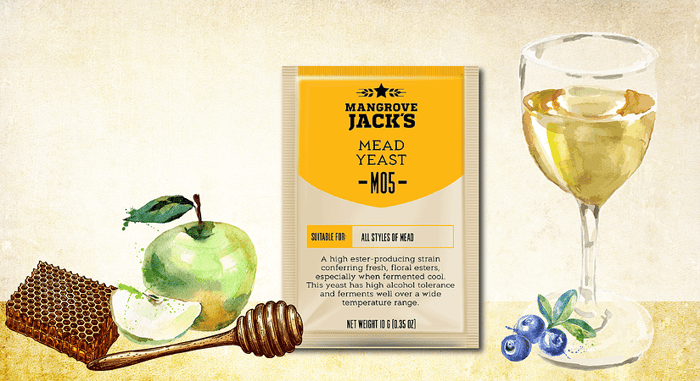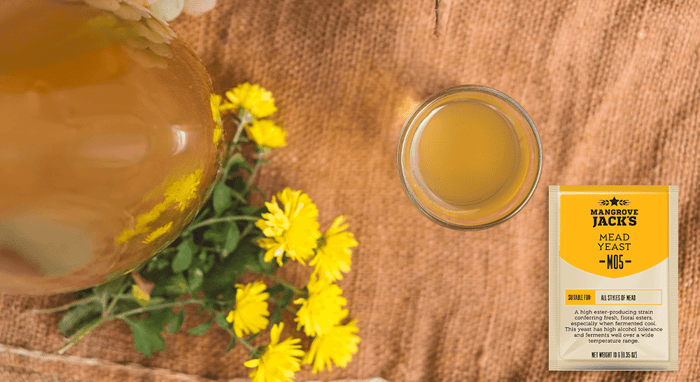Fruit and honey go together as well as, well fruit and honey. Melomels are their name and deliciousness is their game! This week, we’re sharing a Blueberry Apple Melomel Recipe with a red wine tannic component, offering lingering blueberry and apple flavors.
While honey is high in fermentable sugars, it is low in minerals and nutrients and has mild antiseptic properties, which makes fermentation more challenging for yeast. To ensure a healthy fermentation, additional nutrients are needed.
There are many yeast strains available for mead, these can be liquid or dry yeasts. Liquid yeasts will require a starter and nutrients, and dry yeast will require rehydration and nutrients before pitching. We recommend using Mangrove Jack's M05 Mead Yeast and Mangrove Jack's Mead Nutrient.
For calculations, we use the Mead Made Right TOSNA calculator. Mangrove Jack's Mead Nutrient can be used as a replacement for Go ferm during the rehydration phase and as a replacement for Fermaid O during the fermentation.
Makes: 19 L
Approximate ABV: 11%
Note: The SG points added by honey can vary depending on the type of honey and the season.
EQUIPMENT:
- Fermenter 25-30 l (6-8 gal)
- Hydrometer
- 250ml container
- Large container for water bath
- Thermometer
- Sanitiser
- Aluminium foil
- Stainless steel or plastic mash paddle
- Medium, fine mesh grain bag for fruit
INGREDIENTS:
- 3 kg Liquid Honey
- 1 x Mangrove Jack's Apple Cider Pouch
- 1 kg Frozen Blueberries (Thawed out)
- 20 L Non-chlorinated water
- 50 g Wine or Mead nutrient
- 12 g Mangrove Jack's M05 Mead Yeast
- 18.3 g Mangrove Jack's Mead Nutirent
INSTRUCTIONS
1. Clean and sanitize all equipment.
2. If the yeast is cold, let it warm to room temperature.
Prepare Must:
3. Dilute your honey and cider pouch into 10 L (3 gal) of warm water (<55 °C / 131 °F) in the fermenter.
4. Gently break up the thawed blueberries, empty them into the sanitised grain bag, tie the end, and add to the fermenter.
5. Fill the fermenter with water to a 19 L (5 gal) volume.
Rehydrate Yeast:
6. In a sanitised container, prepare sterile non-chlorinated water (10 ml per gram of yeast). Place the container in a water bath to reach 30-40 °C (86-104 °F).
7. Add Mangrove Jack's Mead Nutrient to the water and stir until dissolved.
8. Sprinkle dry yeast over the top, avoiding large clumps. Let sit for 15 minutes, loosely covered with aluminium foil, then stir gently.
9. Stir again to form a cream, then let sit covered for another 5 minutes.
Pitch Yeast:
10. When the cream's temperature is within 8°C of the must, pitch it into the fermenter. If not, gradually add must to the cream until the temperatures match.
11. Ferment at low 16 °C (62 °F).
Nutrient Schedule (TOSNA):
12. At 24 hours after yeast pitch, add 1/4 of the yeast nutrients.
13. At the 48 and 72-hour marks, add another 1/4 of the yeast nutrients.
14. Add the final nutrient addition on the 7th day or when fermentation reaches its 1/3 sugar break (SG = 1.046), whichever comes first.
15. Stir the must gently twice a day until the 1/3 sugar break to release CO2.
16. Once fermentation ceases, rack to a secondary fermenter.
17. Age until clear or add a clarifying agent.
18. Bottle or keg the mead.
19. Enjoy your delicious Blueberry Apple Melomel!




